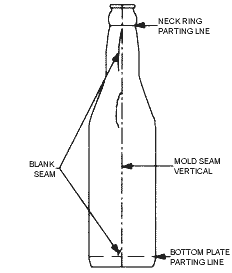|

The Finish
This is the top of the container above the neck ring parting
line.
It includes: The Sealing Surface, Bore, Bead or Collar
The Sealing device is in the finish (see next section), also
the bore or mouth for filling and emptying. The bead or collar
is used to assist in transferring the parison into the blow
mold.
The Neck
The part which extends from the parting line to the curve at the base of the neck.
The Shoulder
This extends from the base of the neck to the straight part of the body.
The Body
The main part of the container which holds the product.
The Bottom
The part of the container on which it stands when upright.
Insweep
The curve between body and bottom which helps to improve glass distribution and thus
strength.
Push-Up
The center of the bottom which is raised up to provide a flat surface on the outer edge of
the bottom and thus provide a firm seating.
When producing a glass container,
various items of mold equipment are used as follows: Blank Mold, Baffle, Plunger, Neck
Ring, Blow Mold and Bottom Plate. Where these individual items join, seams are produced in
the container. If the seams do not meet the standard specified, then the container is
rejected. It is, therefore, essential that all mold equipment be examined in the mold shop
and again in the Production Department. It must also be stored correctly and handled with
care at all times.

Neck
Ring Parting Line
Where the neck ring and the blank mold join, there is a seam.
Blank Seam
The blank mold is in two parts. It closes around the neck ring and then receives the hot
gob of glass. Where the two halves of the blank mold join, there is a seam, which can
sometimes be seen as a wavy line on the finished container.
Baffle Mark
The baffle sits on top of the blank when counterblow takes place to form the parison. If
there is a bad match between blank mold and baffle, then a baffle mark or seam may be seen
in the container bottom.
Mold Seam
The blow mold action is the same as the blank except that is closes around the bottom
plate. Where the two halves join, there is a mold seam, which runs vertically on the whole
length of the container.
Bottom Plate Parting Line
Where the blow mold and bottom plate join there is a seam.
|